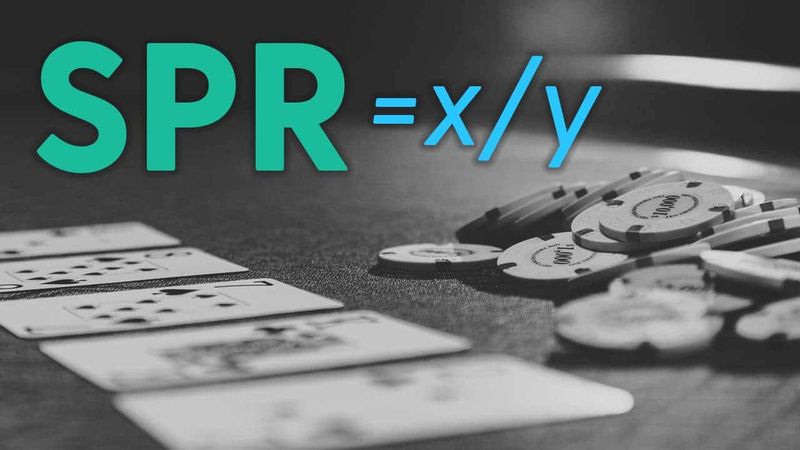The Stack to Pot Ratio (SPR) is the ratio between the amount in the pot and a player's stack, serving as a crucial tool for making strategic decisions in poker. This article will help you understand and apply SPR to improve your poker skills.

What is the Stack-to-Pot Ratio in Poker?
The Stack-to-Pot Ratio (SPR) in poker is a critical metric that helps determine the relationship between the size of your remaining chip stack and the size of the pot at a specific point in the hand.
This ratio plays a vital role in guiding your next decisions, particularly when facing all-in scenarios or deciding on bet sizes during the different betting rounds.

How to Calculate Stack to Pot Ratio
The formula for calculating the Stack to Pot Ratio (SPR) is very simple: SPR = Player's stack size / Current pot size.
For example, if you have 1000 chips left in your stack and the current pot is 200 chips, then your SPR would be: SPR = 1000 / 200 = 5.
The Significance of Stack to Pot Ratio in Poker
The Stack to Pot Ratio (SPR) helps you assess whether you should continue investing in a hand, and also aids in determining whether to take actions like calling, betting, raising, or even folding.
Here’s how SPR influences decisions in different situations:
High Stack to Pot Ratio (around 10 or more)
A high SPR means you have a large number of chips left compared to the size of the pot. In this case, you will have more options and can more easily control the game in the subsequent betting rounds. You may want to play cautiously since decisions can significantly impact the amount you put into the pot.
Appropriate Situation: When SPR is high, you may consider holding on to strong hands and avoid taking risks in hands where you're uncertain.
Average Stack to Pot Ratio (around 5-10)
An average SPR indicates that you still have enough chips to make decisions comfortably, but you shouldn't become overconfident. You need to carefully consider whether your opponent might have a stronger hand and whether you have enough chips to continue making the right decisions in the hand.
Appropriate Situation: When SPR is in this range, you might consider a semi-bluff or make a calculated call if you believe your hand could improve in the following betting rounds.
Low Stack to Pot Ratio (below 5)
A low SPR means you have fewer chips relative to the pot, putting you in tense situations. A low SPR typically occurs when you are deep into a hand and your opponent has more chips than you. In this case, you need to calculate carefully and decide whether you are strong enough to continue through to the end of the hand. Decisions like going all-in may arise when the SPR is low.
Appropriate Situation: When SPR is low, you may want to go all-in with a strong hand, or you may decide to fold if you feel your hand isn't strong enough to continue fighting.

The Importance of Stack to Pot Ratio in Decision Making
The Stack to Pot Ratio (SPR) plays a significant role in how you approach betting situations after the flop and turn, especially when deciding whether to continue calling or to go all-in.
Stack to Pot Ratio and Betting Decisions After the Flop and Turn
Stack to Pot Ratio is an incredibly useful tool for determining the level of risk and your tactical options in each situation. Particularly after the flop and turn, SPR directly influences how you approach the hand.
The relationship between your stack size and the pot size will help you decide whether to slow-play, raise, or even go all-in.
High SPR (>= 8): When SPR is high, you have a large stack compared to the pot, which means you still have many tactical options. In this case, you can slow-play and see how your opponent acts in the upcoming betting rounds. With a high SPR, you can typically pursue your hand without the concern of being forced into an all-in situation too early. If you have a strong hand (such as a straight, flush, or a high pair), you can choose to slow-play to entice your opponent into raising and continue putting money into the pot.
Low SPR (< 4): On the other hand, when SPR is low, you don’t have as many options and need to make a quick decision. If you have a strong hand, a low SPR will often force you to go all-in earlier to maximize your stack. A low SPR typically occurs when you have a small amount of money left in your stack relative to the pot, and slow-playing is no longer feasible. At this point, you will need to evaluate your hand’s strength and decide whether to go all-in.
All-in Situations and Stack to Pot Ratio
Stack to Pot Ratio is a key factor in determining whether to go all-in. When SPR is low, you often don't have many choices other than to push all-in, especially if you have a strong hand. Going all-in in these situations helps you maximize the value of your strong hand while minimizing the risk of your opponent taking control of the game.
For example, if you have a high pair or a strong hand, with a low SPR, going all-in will put pressure on your opponent, forcing them to make a tough decision, and possibly even causing them to fold. However, with a high SPR, you can opt for other strategies like check-calling or raising to encourage your opponent to continue betting into the pot, creating opportunities to win in the later betting rounds.

In conclusion, the Stack to Pot Ratio (SPR) is a powerful tool to help you make decisions in poker. By understanding how to calculate and apply SPR in specific situations, you can assess the level of risk in your bets and determine whether you should continue investing in the hand.
The flexibility in playing poker, depending on the SPR, can help you optimize your strategy and increase your chances of winning.





























